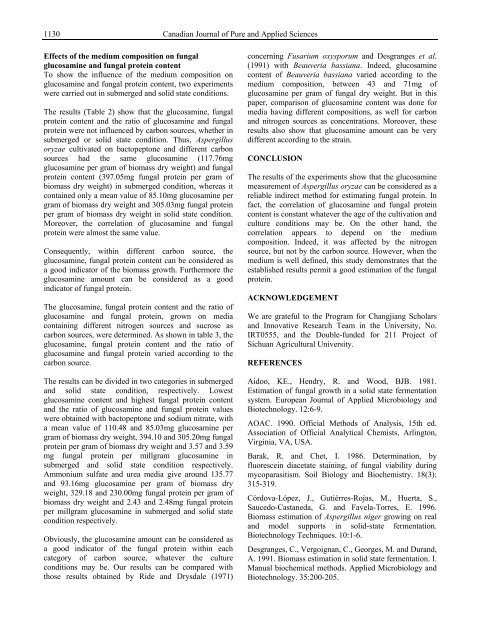Download (5Mb) - Covenant University Repository
Download (5Mb) - Covenant University Repository
Download (5Mb) - Covenant University Repository
You also want an ePaper? Increase the reach of your titles
YUMPU automatically turns print PDFs into web optimized ePapers that Google loves.
1130<br />
Effects of the medium composition on fungal<br />
glucosamine and fungal protein content<br />
To show the influence of the medium composition on<br />
glucosamine and fungal protein content, two experiments<br />
were carried out in submerged and solid state conditions.<br />
The results (Table 2) show that the glucosamine, fungal<br />
protein content and the ratio of glucosamine and fungal<br />
protein were not influenced by carbon sources, whether in<br />
submerged or solid state condition. Thus, Aspergillus<br />
oryzae cultivated on bactopeptone and different carbon<br />
sources had the same glucosamine (117.76mg<br />
glucosamine per gram of biomass dry weight) and fungal<br />
protein content (397.05mg fungal protein per gram of<br />
biomass dry weight) in submerged condition, whereas it<br />
contained only a mean value of 85.10mg glucosamine per<br />
gram of biomass dry weight and 305.03mg fungal protein<br />
per gram of biomass dry weight in solid state condition.<br />
Moreover, the correlation of glucosamine and fungal<br />
protein were almost the same value.<br />
Consequently, within different carbon source, the<br />
glucosamine, fungal protein content can be considered as<br />
a good indicator of the biomass growth. Furthermore the<br />
glucosamine amount can be considered as a good<br />
indicator of fungal protein.<br />
The glucosamine, fungal protein content and the ratio of<br />
glucosamine and fungal protein, grown on media<br />
containing different nitrogen sources and sucrose as<br />
carbon sources, were determined. As shown in table 3, the<br />
glucosamine, fungal protein content and the ratio of<br />
glucosamine and fungal protein varied according to the<br />
carbon source.<br />
The results can be divided in two categories in submerged<br />
and solid state condition, respectively. Lowest<br />
glucosamine content and highest fungal protein content<br />
and the ratio of glucosamine and fungal protein values<br />
were obtained with bactopeptone and sodium nitrate, with<br />
a mean value of 110.48 and 85.03mg glucosamine per<br />
gram of biomass dry weight, 394.10 and 305.20mg fungal<br />
protein per gram of biomass dry weight and 3.57 and 3.59<br />
mg fungal protein per millgram glucosamine in<br />
submerged and solid state condition respectively.<br />
Ammonium sulfate and urea media give around 135.77<br />
and 93.16mg glucosamine per gram of biomass dry<br />
weight, 329.18 and 230.00mg fungal protein per gram of<br />
biomass dry weight and 2.43 and 2.48mg fungal protein<br />
per millgram glucosamine in submerged and solid state<br />
condition respectively.<br />
Obviously, the glucosamine amount can be considered as<br />
a good indicator of the fungal protein within each<br />
category of carbon source, whatever the culture<br />
conditions may be. Our results can be compared with<br />
those results obtained by Ride and Drysdale (1971)<br />
Canadian Journal of Pure and Applied Sciences<br />
concerning Fusarium oxysporum and Desgranges et al.<br />
(1991) with Beauveria bassiana. Indeed, glucosamine<br />
content of Beauveria bassiana varied according to the<br />
medium composition, between 43 and 71mg of<br />
glucosamine per gram of fungal dry weight. But in this<br />
paper, comparison of glucosamine content was done for<br />
media having different compositions, as well for carbon<br />
and nitrogen sources as concentrations. Moreover, these<br />
results also show that glucosamine amount can be very<br />
different according to the strain.<br />
CONCLUSION<br />
The results of the experiments show that the glucosamine<br />
measurement of Aspergillus oryzae can be considered as a<br />
reliable indirect method for estimating fungal protein. In<br />
fact, the correlation of glucosamine and fungal protein<br />
content is constant whatever the age of the cultivation and<br />
culture conditions may be. On the other hand, the<br />
correlation appears to depend on the medium<br />
composition. Indeed, it was affected by the nitrogen<br />
source, but not by the carbon source. However, when the<br />
medium is well defined, this study demonstrates that the<br />
established results permit a good estimation of the fungal<br />
protein.<br />
ACKNOWLEDGEMENT<br />
We are grateful to the Program for Changjiang Scholars<br />
and Innovative Research Team in the <strong>University</strong>, No.<br />
IRT0555, and the Double-funded for 211 Project of<br />
Sichuan Agricultural <strong>University</strong>.<br />
REFERENCES<br />
Aidoo, KE., Hendry, R. and Wood, BJB. 1981.<br />
Estimation of fungal growth in a solid state fermentation<br />
system. European Journal of Applied Microbiology and<br />
Biotechnology. 12:6-9.<br />
AOAC. 1990. Official Methods of Analysis, 15th ed.<br />
Association of Official Analytical Chemists, Arlington,<br />
Virginia, VA, USA.<br />
Barak, R. and Chet, I. 1986. Determination, by<br />
fluorescein diacetate staining, of fungal viability during<br />
mycoparasitism. Soil Biology and Biochemistry. 18(3):<br />
315-319.<br />
Córdova-López, J., Gutiérres-Rojas, M., Huerta, S.,<br />
Saucedo-Castaneda, G. and Favela-Torres, E. 1996.<br />
Biomass estimation of Aspergillus niger growing on real<br />
and model supports in solid-state fermentation.<br />
Biotechnology Techniques. 10:1-6.<br />
Desgranges, C., Vergoignan, C., Georges, M. and Durand,<br />
A. 1991. Biomass estimation in solid state fermentation. I.<br />
Manual biochemical methods. Applied Microbiology and<br />
Biotechnology. 35:200-205.

















